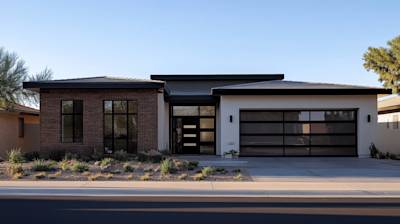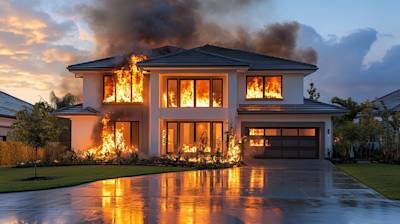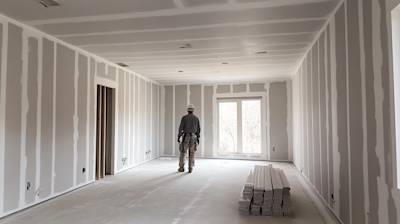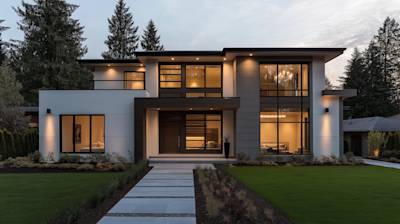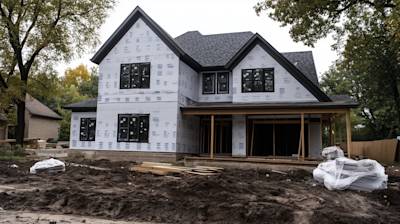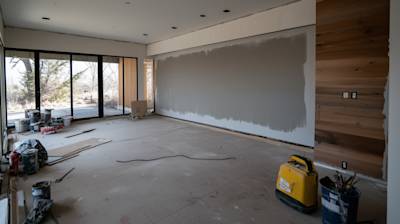EIFS stucco, also known as Exterior Insulation and Finish Systems, is a type of wall cladding system that provides exterior walls with an insulated finished surface and a waterproof barrier. Being a contemporary solution to traditional stucco, it's gaining popularity in residential and commercial buildings due to its energy efficiency, versatility in design, and durability. This blog post will delve into the in-depth explanation of EIFS stucco, its types, applications, and comparison with traditional stucco.
Understanding EIFS Stucco
EIFS arose in the post-war years, primarily in Europe, as a visually appealing alternative to standard wall systems. Its journey to the United States dates back to the 1960s. Today, EIFS is a popular choice for both residential and commercial structures, giving buildings a sophisticated, clean look while also providing excellent insulation.
Components of EIFS Stucco
EIFS has three essential components. The innermost layer, known as the foam insulation board, is directly attached to the exterior wall surface. On top of this insulation board is a middle layer comprised of polymer and cement base coats, reinforced with a glass fiber mesh. The final component is the textured finish coat, which is both durable and weather-resistant.
Types of EIFS Stucco
There are primarily two types of EIFS – Traditional EIFS and EIFS with Drainage.
- Traditional EIFS: Also known as barrier EIFS, it consists of adhesive, insulation board, base coat, reinforcement mesh, and finish coat. It's designed to act as a barrier to water penetration making it highly weather-resistant.
- EIFS with Drainage: Often referred to as water-managed EIFS, it includes a drainage system that helps to eliminate the water that penetrates into the wall cladding. It is considered more effective in areas with heavy rainfall or high moisture levels.
EIFS Stucco Vs Conventional Stucco
While both EIFS and traditional stucco are used as cladding for buildings, they vary primarily in composition, cost, insulation, and durability. Traditional stucco, composed of cement, sand, lime, and water, is a hard, dense, thick, and non-insulative material. In contrast, EIFS is a multi-layer system that uses foam insulation to provide superior energy efficiency. EIFS also weighs less than traditional stucco, reducing the load on the building structure. With proper installation and maintenance, EIFS can match or surpass the durability of conventional stucco.
Key Features of EIFS Stucco
Let's discuss some key features that make EIFS a popular choice today.
- Eco-friendly: Due to its excellent thermal insulation properties, EIFS reduces energy consumption, thereby lowering CO2 emissions.
- Design Versatility: EIFS can be designed to look like any other material – wood, stone, or brick – offering aesthetic flexibility to architects.
- Cost-Effective: Although EIFS might have a higher initial cost compared to traditional stucco, it outperforms over the long run because of its durability and energy efficiency.
- Durability: EIFS is known for its resistance to cracks and general wear and tear. It's also resistant to moulds, mildews, and fungi, contributing to a healthier indoor environment.
Installation of EIFS Stucco
Installation of EIFS is a meticulous process and must be done by professionals to ensure durability and effectiveness. The process involves attaching the EIFS to the supporting structure, application of the base coat and mesh for reinforcement, followed by the application of the finish coat. Services of a professional EIFS contractor should be employed to ensure that the job is done correctly.
Maintenance and Repair of EIFS Stucco
Maintenance of EIFS stucco is relatively simple and involves regular cleaning and inspections for any damage or water infiltration. Any cracks or punctures in the system need to be repaired immediately to prevent further damage. Regular maintenance services by an EIFS professional can help extend the life of the cladding system.
To conclude, EIFS is undoubtedly a game-changer in the cladding industry. It offers homeowners a plethora of benefits such as energy efficiency, design versatility, and durability, and with proper installation and maintenance, it can be a cost-effective alternative to traditional stucco. As the understanding of EIFS grows, it's expected to become an even more popular choice in the future.
Frequently Asked Questions about EIFS Stucco and related Topics
How does EIFS Stucco differ from traditional stucco?
EIFS (Exterior Insulation Finishing System) stucco is a type of exterior cladding that is applied to the outside of a building. It's different from traditional stucco, which is a plaster-based material. EIFS is a multi-layered system that includes insulation, a water barrier, a base coat, and a finish coat. It provides better insulation than traditional stucco and is also more flexible, reducing the risk of cracking.
How is EIFS Stucco applied?
Application of EIFS stucco is a multi-step process that should be done by professionals. First, a layer of foam insulation is attached to the exterior wall of the building. Next, a water-resistant barrier is applied over the insulation. The third step is to apply a base coat that has a mesh embedded in it for strength. Finally, a finish coat is applied which can be customized in color and texture per your preference.
Can EIFS Stucco be used in homes?
Absolutely, EIFS stucco can definitely be used in homes. Its primary benefits are its excellent insulation properties, its flexibility (which reduces the likelihood of cracks), and its aesthetic appeal. All of these make it an excellent choice for home exteriors. However, it's important to ensure that the application is done by a professional to avoid any moisture intrusion issues.
What is the lifespan of EIFS Stucco?
With proper installation and maintenance, EIFS Stucco can last for several decades. Regular inspection for any damages and prompt repairs, if necessary, can greatly extend the life of the EIFS. It is also crucial to ensure that the system is not punctured or breached as it would compromise its water resistance.
Can EIFS Stucco be painted?
Yes, EIFS Stucco can be painted. In fact, one of the advantages of this kind of siding material is that it holds on to paint very well. You can choose any color that matches your home's aesthetic. However, make sure to use a paint that is suitable for exterior use and compatible with the EIFS surface.
How to maintain EIFS Stucco?
EIFS Stucco requires minimal maintenance. Regular inspection to detect any potential issues is the key. Look for cracks or any signs of physical damage and get it repaired immediately. Cleaning the exterior occasionally with a gentle bleach solution can prevent buildup of dirt and mildew.
How often should EIFS Stucco be sealed?
Generally, EIFS Stucco does not need to be sealed often, because the finish coat is designed to be long-lasting and weatherproof. But, if it is exposed to extremely harsh weather conditions or gets damaged, a new sealant might be necessary. It is recommended to get your EIFS Stucco inspected and sealed (if necessary) by a professional every three to five years.
What should I do if I notice cracks in the EIFS Stucco?
If you notice cracks in your EIFS stucco, it’s essential that you take immediate steps to get it repaired. Cracks can expose the underlying layers to moisture, which can lead to bigger problems down the road. Be sure to contact a professional who specializes in EIFS Stucco to ensure the repair is done correctly.
Is EIFS Stucco eco-friendly?
Yes, EIFS Stucco is considered to be eco-friendly. The main component, polystyrene, is recyclable and the manufacturing process is less energy-intensive than that of conventional stucco. Additionally, its superior insulating properties can reduce the energy needed for heating and cooling of the building, therefore, reducing the building's carbon footprint.
Detail on the Pros and Cons of EIFS Stucco
Pros of EIFS Stucco
Energy Efficiency
One of the primary benefits of EIFS stucco is its superior insulation properties. This exterior finish drastically reduces air infiltration, making it a significant energy-efficient solution for houses and buildings. It helps drastically lower energy consumption by ensuring regulation of the internal temperature.
Design Versatility
Another advantage of the EIFS stucco is its incredible design versatility. It can imitate various architectural styles and details such as arched windows, cornices, keystones, or even intricate stone details. This flexibility in design allows architects and homeowners to create customized solutions that match their aesthetic preferences.
Low Maintenance
EIFS stucco requires very little maintenance. It doesn't crack easily, nor will it require frequent painting. This makes it a cost-effective choice in the long-run for homeowners who wish to minimize upkeep efforts.
Moisture Management
EIFS Stucco is designed to deflect water away from the building, therefore ensuring better moisture management. This characteristic contributes to the protection and longevity of the structure.
Cons of EIFS Stucco
Susceptibility to Damage
While EIFS stucco is robust and offers high endurance, it is still susceptible to damage from sharp objects and hard-hitting impacts. This means that things like hail, debris flung by high winds, or even an errant baseball could cause visible dents or gouges.
Improper Installation Issues
EIFS stucco installation requires a high level of expertise. Consequently, any mistakes during the installation process could lead to severe problems later, including water intrusion and structural damage. So, choosing an experienced and qualified contractor is crucial when deciding to use EIFS stucco.
Moisture Retention
Despite its excellent moisture management, in certain circumstances, EIFS stucco can retain moisture, which can lead to underlying structural damage. This typically occurs when there is a malfunction or error in the application process.
Repair Cost
If damaged, EIFS stucco repair costs can be relatively high. This is due to the complexity of the repair process, which often requires qualified professionals.
Variations of EIFS Stucco
Classic EIFS
Also known as traditional or barrier EIFS, classic EIFS is the original variation. This type does not incorporate a drainage system. It mainly consists of a base layer, reinforcement layer, and a finish layer.
Drainable/Drained EIFS
This is a modified version of the classic EIFS meant to improve moisture management. A drainage system is incorporated into the design to allow moisture that may infiltrate the system to escape.
Water-Managed EIFS
This variation of EIFS incorporates both water-resistive and air-resistive barriers. These barriers are installed behind the foam insulation board to offer more advanced moisture control.
A Detailed Comparison of EIFS Stucco and Traditional Stucco
The decision to choose between EIFS stucco and traditional stucco essentially boils down to your specific circumstances and requirements. Here's a comparison to help figure out what might work best for you:
Energy Efficiency:- EIFS Stucco: Offers superior insulation and is considered more energy-efficient.
- Traditional Stucco: Less energy-efficient compared to EIFS.
- EIFS Stucco: Not as durable as traditional stucco, and more susceptible to incidental impacts.
- Traditional Stucco: Highly durable, resistant to impacts.
- EIFS Stucco: Requires professional installation for a successful, long-lasting finish.
- Traditional Stucco: Installation could be less complex, though professional installation would still be suggested for best results.
- EIFS Stucco: Requires less maintenance than traditional stucco.
- Traditional Stucco: may require repainting and sealing every few years.
- EIFS Stucco: Good moisture management, but improper installation can lead to serious problems.
- Traditional Stucco: Allows wall system to breathe, but can be prone to cracking and moisture intrusion.
- EIFS Stucco: More cost-effective in terms of energy conservation but requires professional installation.
- Traditional Stucco: Lower upfront costs, but potentially more maintenance over time.
Summary
EIFS stucco has transformed the exterior décor of buildings with its remarkable flexibility and durability. It requires less maintenance compared to traditional stucco, making it a cost-effective choice, while also providing excellent thermal insulation. Besides, it adds an aesthetic appeal to residential and commercial properties and it proves that beauty and functionality can both come hand in hand.
Versatility is also a major benefit of the EIFS stucco. This system allows for any color, texture, or architectural detail, so it can match any specific design requirements. Its source materials are environmentally friendly, contributing to a sustainable lifestyle. For people looking for a perfect blend of artistry, durability, and efficiency, this exterior finish can be an ideal choice.
Though proactive measures are needed to safeguard EIFS stucco from moisture damage, these are small drawbacks to an otherwise excellent building material. Regular inspection and upkeep, proper installation and use of good quality materials can ensure long-lasting performance. Therefore, for those seeking a balance between an artisan touch and modern convenience in their building's exterior, EIFS stucco may well be the perfect solution!
About Atlas Stucco
Meet Atlas Stucco, located in the heart of Sacramento, CA - a professional company that have been serving the community with their top-class stucco services for years. We're a team of experts who are passionate about creating and maintaining beautiful, resilient stucco homes or businesses that stand the test of time. We pride ourselves on our commitment to quality, customer satisfaction and respect for your property. At Atlas Stucco, your vision is our mission and we look forward to turning your stucco dreams into reality. Connect with us today to experience the Atlas difference!
Tags: EIFS Stucco, Stucco Installation, Stucco Maintenance,



